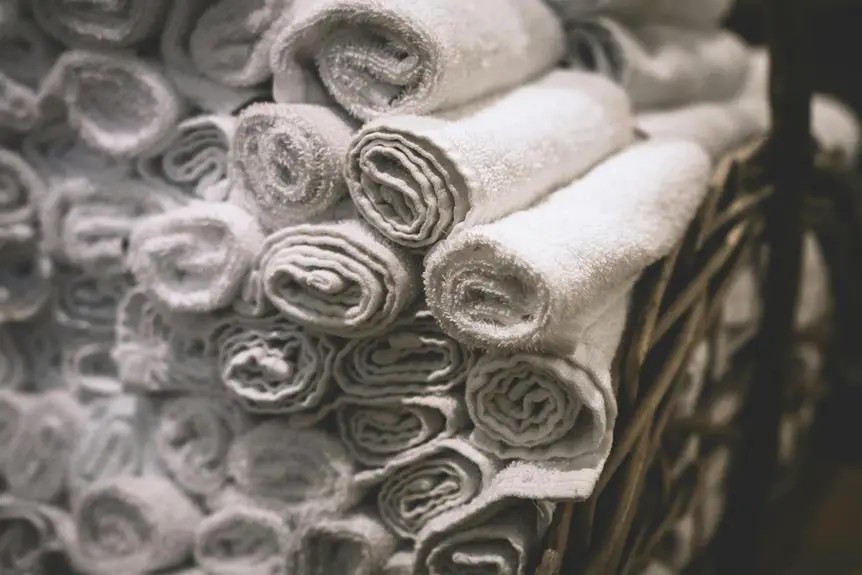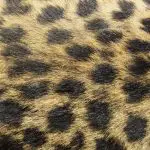Do you find yourself frustrated by the presence of tiny black dots on your bathroom fabrics? Mold and mildew can quickly invade these areas, causing unsightly and potentially harmful issues.
In this guide, you will learn effective methods to combat and prevent this common problem. By understanding the causes, identifying problem areas, and implementing natural remedies, you can regain control over your bathroom fabrics.
Additionally, discovering preventative measures and seeking professional help when needed will contribute to a mold-free environment. With the knowledge and strategies provided, you can confidently address the presence of tiny black dots on your bathroom fabrics and ensure a clean and healthy space for yourself and your family.
Key Takeaways
- High humidity and poor ventilation are the main causes of mold growth on bathroom fabrics.
- Identifying and addressing sources of high humidity, such as leaks and inadequate ventilation, is essential in preventing mold growth.
- Effective cleaning methods for removing mold from bathroom fabrics include using mildew-resistant cleaners, gentle scrubbing, and thorough rinsing and drying.
- Natural remedies like tea tree oil, white vinegar, and sunlight exposure can supplement regular cleaning routines to combat the presence of mold.
Understanding the Causes
If you notice tiny black dots on your bathroom fabrics, the most likely cause is mold growth due to high humidity and poor ventilation.
Identifying sources of high humidity in your bathroom is crucial for preventing mold growth. Common sources include hot showers, baths, and even cooking, which can release moisture into the air. Additionally, leaks in plumbing or the roof can contribute to increased humidity levels.
To prevent mold growth, it's important to address these sources by using exhaust fans during and after bathing, fixing any leaks promptly, and using a dehumidifier if necessary.
Proper ventilation is also key in preventing mold. Ensure that your bathroom is well-ventilated by opening windows or using exhaust fans to allow moist air to escape.
Taking these prevention strategies seriously can help you avoid the unsightly and potentially harmful effects of mold growth on your bathroom fabrics.
Regular maintenance, vigilance, and a proactive approach are essential in keeping your bathroom free from mold and its associated problems.
Identifying the Problem Areas
Check your bathroom for signs of moisture and dampness, especially in areas such as around the shower, bathtub, and sink. Identifying problem areas is crucial in addressing the issue of tiny black dots on bathroom fabrics. Use the following table to help you locate potential sources of moisture and dampness in your bathroom, and take preventive measures to avoid reoccurrence.
| Problem Area | Signs of Moisture and Dampness | Preventive Measures |
|---|---|---|
| Shower | Peeling paint or wallpaper, musty odor | Use exhaust fans, fix any leaks |
| Bathtub | Damp or discolored caulking, damp grout lines | Re-caulk, repair grout |
| Sink | Water stains, damp cabinets | Fix leaks, keep area dry |
Effective Cleaning Methods
To effectively prevent the reoccurrence of tiny black dots on bathroom fabrics, regularly clean the problem areas using a mildew-resistant cleaner at least once a week. When cleaning, follow these effective methods for fabric care and mold prevention:
- Use Mildew-Resistant Cleaners: Choose a cleaner specifically formulated to prevent mold and mildew. These cleaners effectively remove existing mold and prevent its return.
- *Apply Directly*: Spray or apply the cleaner directly to the affected areas. Allow it to sit for the recommended time to ensure effective mold removal.
- *Scrub Gently*: Use a soft-bristled brush or sponge to gently scrub the fabric. Be thorough but avoid harsh scrubbing that could damage the fibers.
- *Rinse and Dry Thoroughly*: After cleaning, rinse the fabric thoroughly with clean water. Ensure the fabric is completely dry before returning it to use.
By following these cleaning methods, you can effectively care for your bathroom fabrics and prevent the growth of mold and mildew.
Regular cleaning and maintenance are essential to keep your bathroom fabrics clean, fresh, and free from tiny black dots.
Natural Remedies to Try
You can also consider using natural remedies to supplement your cleaning routine and further combat the presence of tiny black dots on your bathroom fabrics.
Herbal solutions such as tea tree oil, known for its antifungal properties, can be effective in eliminating mold and mildew. Simply dilute a few drops of tea tree oil in water and spray the solution onto the affected areas. Let it sit for a few hours before washing the fabric as usual.
Another home treatment involves using white vinegar, which is a natural disinfectant and can help kill mold and mildew. Mix equal parts of water and white vinegar in a spray bottle, then spray the solution onto the affected areas and allow it to dry.
Additionally, exposing the fabrics to direct sunlight can also aid in killing mold and mildew due to its natural antibacterial properties.
After applying these natural remedies, ensure that the fabrics are thoroughly washed and dried to prevent further mold growth.
Using Preventative Measures
To prevent the recurrence of tiny black dots on your bathroom fabrics, regularly inspect for moisture buildup and promptly address any dampness or leaks. Implementing preventative measures is crucial to avoiding mold growth and preserving the quality of your bathroom fabrics. Here are some fabric care techniques and preventative measures to consider:
- Proper Ventilation:
- Use exhaust fans or open windows during and after showers to reduce moisture in the air.
- Consider using a dehumidifier in the bathroom to maintain optimal humidity levels.
- Regular Cleaning:
- Wash and dry bathroom fabrics frequently to prevent mold and mildew from developing.
- Use a mold-inhibiting laundry additive to protect fabrics from mold growth.
- Maintenance:
- Regularly inspect the bathroom for any leaks or water damage, especially around sinks, toilets, and bathtubs.
- Repair any leaks promptly and ensure that all plumbing fixtures are in good working condition.
Seeking Professional Help
If you're dealing with stubborn mold infestations, it might be time to seek professional help. Mold removal experts have the knowledge and tools to effectively eliminate mold from your bathroom fabrics.
Trained remediation specialists and professional cleaning services can ensure that the job is done thoroughly and safely.
Mold Removal Experts
Consider contacting at least three mold removal experts to assess the extent of the problem and provide professional remediation recommendations. When seeking professional help for mold removal, it's essential to keep the following points in mind:
- Expertise: Look for professionals with extensive experience in mold remediation to ensure effective and thorough removal.
- Certifications: Verify that the experts hold relevant certifications and licenses, such as those from the Institute of Inspection, Cleaning and Restoration Certification (IICRC).
- References: Request references and check online reviews to gauge the quality of their work and customer satisfaction.
Seeking assistance from mold removal experts is crucial for effectively tackling mold issues, especially when DIY solutions haven't yielded satisfactory results and for implementing comprehensive mold prevention strategies.
Trained Remediation Specialists
When seeking professional help for mold removal, ensure that you contact trained remediation specialists with extensive experience and relevant certifications. These specialists are equipped with the knowledge and expertise to tackle mold issues effectively. They employ advanced remediation techniques, such as HEPA vacuuming, antimicrobial treatments, and specialized cleaning methods, to eliminate mold from your bathroom fabrics.
Moreover, trained remediation specialists can provide valuable insights into prevention strategies to safeguard your home from future mold infestations. By thoroughly assessing the root cause of mold growth, they can offer recommendations to address underlying moisture issues and improve ventilation, ultimately preventing mold from reoccurring.
Seeking assistance from these professionals ensures a comprehensive approach to mold remediation and empowers you to maintain a healthy and mold-free environment in your home.
Professional Cleaning Services
Contact professional cleaning services to ensure thorough and effective removal of mold from your bathroom fabrics, complementing the expertise of trained remediation specialists in maintaining a healthy and mold-free environment in your home.
When seeking professional help for mold inspection and fungus removal, consider the following:
- Expertise: Professional cleaning services have the necessary expertise and experience in dealing with mold and fungus removal, ensuring a comprehensive and effective solution.
- Specialized Equipment: These services are equipped with specialized tools and cleaning agents that are specifically designed for mold and fungus removal, ensuring the thorough cleaning of your bathroom fabrics.
- Preventive Measures: In addition to removal, professional cleaning services can also provide recommendations for preventive measures to inhibit the recurrence of mold and fungus, contributing to a long-term solution for your home.
Maintaining a Mold-Free Environment
To maintain a mold-free environment in your bathroom, regularly wash and dry fabrics such as towels and shower curtains. Additionally, ensure proper bathroom ventilation to prevent mold growth. Mold thrives in damp, humid environments, making bathrooms an ideal breeding ground. Here are some practical tips to uphold a mold-free environment:
| Task | Frequency | Additional Tips |
|---|---|---|
| Wash towels and bath mats | Every 3-4 uses | Use hot water and a cup of vinegar in the rinse cycle to kill mold spores. |
| Clean shower curtains | Monthly | Use a mixture of water and bleach to eliminate mold and mildew. |
| Vacuum bathroom mats and rugs | Weekly | Ensure they are completely dry before placing them back in the bathroom. |
| Wipe down bathroom surfaces | Weekly | Use a mold-inhibiting cleaner to prevent mold growth. |
| Check and maintain bathroom ventilation | Biannually | Ensure vents are clean and functioning properly to reduce moisture buildup. |
Frequently Asked Questions
Can Tiny Black Dots on Bathroom Fabrics Cause Any Health Issues?
Tiny black dots on bathroom fabrics can cause health concerns if left untreated. To remove them, use a mixture of vinegar and water to clean the affected area. Regular cleaning and proper ventilation can help prevent their return.
Is It Possible for These Tiny Black Dots to Spread to Other Areas of the Bathroom?
To prevent the spread of tiny black dots in your bathroom, regularly clean and dry fabrics, use mold-resistant materials, and maintain proper ventilation. This will help to maintain bathroom aesthetics and prevent further issues.
Are There Any Specific Types of Fabric That Are More Prone to Developing These Black Dots?
When choosing bathroom fabrics, consider moisture-resistant materials like polyester or nylon to prevent black dot development. Regularly clean fabrics with bleach or vinegar to prevent mold growth. Establish a fabric maintenance routine to uphold cleanliness.
Can These Black Dots Be a Sign of a Larger Mold Problem in the Bathroom?
Tiny black dots on bathroom fabrics could indicate a larger mold problem. To prevent mold, keep fabrics dry, and well-ventilated. Regularly clean and maintain bathroom fabrics to prevent mold growth. Address any mold issues promptly.
How Often Should I Replace Bathroom Fabrics to Prevent the Growth of These Black Dots?
To prevent mold growth, replace bathroom fabrics like towels and shower curtains every 3-6 months. Wash them regularly with hot water and bleach to keep them clean. Proper fabric care is essential for preventing mold in the bathroom.
- Can You Get Organza Wet? - April 23, 2024
- Why Is Organza so Popular? - April 23, 2024
- What Do You Wear With Organza? - April 23, 2024




